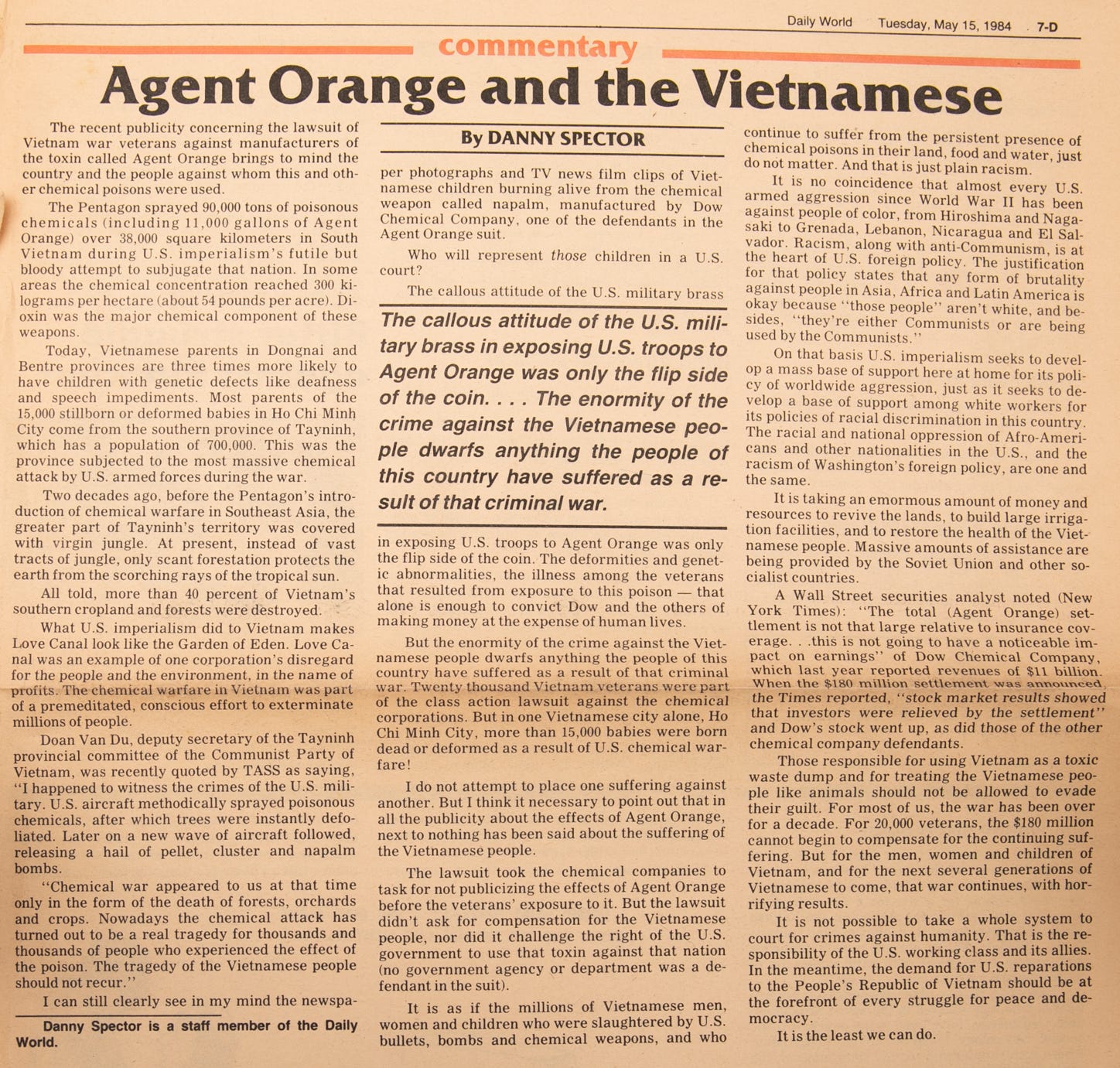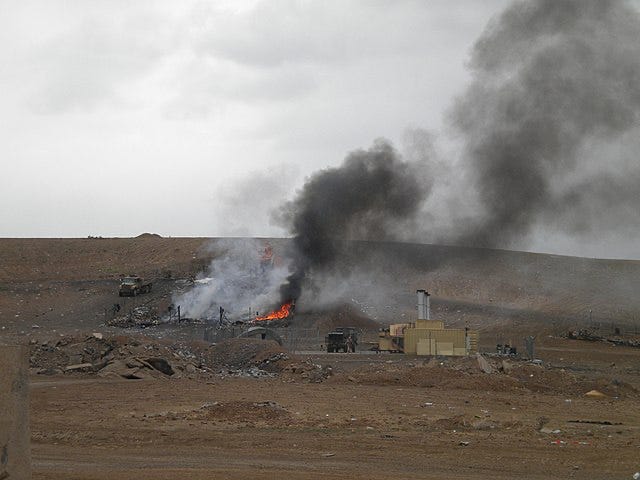Burn Pits and the Iraqis
I wrote satire, features, news articles, and commentary for the newspaper of the Communist Party, USA in the 1980s and early 1990s. We will reprint some of them in this Thoughts-letter, especially when the issues they raised are relevant to current struggles.
On February 25, 2008, Reuters reported that “a federal appeals court upheld … the dismissal of a civil lawsuit against major U.S. chemical companies brought by Vietnamese plaintiffs” over the use of Agent Orange during the war. A U.S. District Court judge had ruled in March 2005 that
“Although the herbicide campaign may have been controversial, the record before us supports the conclusion that agent orange was used as a defoliant and not as a poison designed for or targeting human populations.”
Reuters continued:
The United States has maintained there is no scientifically proven link between the wartime spraying and the claims of dioxin poisoning by more than 3 million people in Vietnam. The U.S. government, which claimed sovereign immunity, was not sued.
History.com noted in 2019:
Fred A. Wilcox, author of Scorched Earth: Legacies of Chemical Warfare in Vietnam, told the Vietnamese news source VN Express International, “The U.S. government refuses to compensate Vietnamese victims of chemical warfare because to do so would mean admitting that the U.S. committed war crimes in Vietnam. This would open the door to lawsuits that would cost the government billions of dollars.”
(The United States signed the 1925 Geneva Protocol for the Prohibition of the Use in War of Asphyxiating, Poisonous or Other Gases and of Bacteriological Methods of Warfare, but didn’t ratify the protocol until 1975.)
In 2019 SCMP.com reported that “Today, more than 3 million Vietnamese, spanning four generations, suffer from health conditions linked to Agent Orange, says the Vietnamese Association for Victims of Agent Orange (VAVA), which has been fighting for compensation.” A Canadian environmental consultant told SCMP.com that the country “might see another six to 12 more generations of Agent Orange victims.” A likely reason is that the food supply is still contaminated with dioxin, which the Environmental Protection Agency calls a “persistent organic pollutant” because it takes a long time to break down in the environment.
According to the North Dakota Veterans Administration, “roughly 300-thousand veterans have died from Agent Orange exposure — that’s almost five times as many as the 58-thousand who died in combat.”
PBS produced a 10-minute video in 2014 that provides information on what happened in the 30 years after I wrote this commentary. In summary — not enough: The U.S. government gave the Veterans Administration more money to take care of veterans exposed to dioxin, and the government helped Vietnam clean up the dioxin-laden soil at the former Agent Orange storage site at Da Nang airport. No one at the chemical manufacturers or in the U.S. government admitted responsibility or apologized (although the manufacturers knew in 1965 about dioxin’s effects), no one was held legally or morally responsible for that war crime, dozens of sites in Vietnam are still contaminated, and the U.S. government has not paid reparations to the Vietnamese families who continue to suffer the effects of dioxin exposure.
***
In the 2000s, veterans of the U.S. wars in Afghanistan and Iraq began complaining to the VA that they had gone to war healthy and had come back with rare diseases that they said were caused by exposure to burn pits. The military’s solution for getting rid of massive amounts of waste was to dig around 230 pits, some as large as two or three football fields, dump the waste — plastics, computers, uniforms, appliances, batteries, medicines, dead animals, petroleum products, wood, food waste, metal, paint, human body parts, human waste, equipment, unexploded ordnance, rubber, etc. — into the pits, pour jet fuel on the waste, and set it on fire.

The resulting plumes of toxic gas and particulate matter spread inside, around, and beyond the bases, and contaminated the land that local families used for agriculture and livestock.
The pits were operated by Kellog, Brown & Root (KBR), which at the time was a subsidiary of Halliburton, Inc. (Dick Cheney was CEO of Halliburton before he became vice president under George W. Bush.) KBR had a multi-million-dollar contract with the Defense Department to manage the pits, among other services, which meant that the civilians working for KBR were also exposed to the toxins.
For years the VA denied a causal connection between burn pit exposure and the consequent raft of diseases, including cancers, neuropathy, and respiratory diseases. For all those years, veterans’ health deteriorated, many of them died, and their families suffered.
Hundreds of veterans sued KBR, claiming that the company was negligent in exposing them to the toxins. The case went up to the Supreme Court, which upheld lower court rulings that because KBR was acting under the supervision of the Defense Department, it was immune from liability.
When the U.S. pulled out of Afghanistan and Iraq, it left behind the remains of the burn pits, the polluted soil, and the Iraqi and Afghan families who were exposed to the toxins.
On August 10, Joe Biden signed the Promise to Address Comprehensive Toxics (PACT) Act, which provides $300 billion over 10 years for health coverage for specific medical conditions that are presumed to be related to burn pit exposure. This legal presumption eliminated the VA’s argument that scientific evidence of a causal connection was not available for these conditions. But, as the comedian Jon Stewart said after the bill was signed, “You think [the veterans’] struggles end because the PACT Act passes? All it means is they don’t have to decide between their cancer drugs and their house. Their struggle continues.” As of August 31, more than 325,000 military personnel and veterans had joined the VA’s Airborne Hazards and Open Burn Pit Registry.
What has happened in the 20 years since the U.S. government invaded Iran and Afghanistan and exposed millions of soldiers and civilians to burn pits? In summary — not enough: The U.S. government gave money to the VA to take care of veterans exposed to burn pit toxins. No one at KBR or in the U.S. government admitted responsibility or apologized, dozens of sites in Iraq and Afghanistan are still contaminated, and the U.S. government has not paid reparations to the Iraqi and Afghan families who continue to suffer the effects of burn pit exposure. Although burn pits might not violate the 1925 Protocol (because they are not “asphyxiating, poisonous or other gases” used as instruments of war), the U.S. government is morally responsible for what it did to the people and the land in those countries.
***
There is no daylight between the racism of U.S. domestic policy and the racism of U.S. foreign policy. The U.S. mined uranium from Native American land, dropped uranium on Hiroshima and Nagasaki, and fired artillery shells with depleted uranium at Fallujah, Iraq. Cancer Alley in Louisiana and Grays Ferry in South Philadelphia are the domestic corollaries of burn pits in Iraq and Afghanistan. Paramilitary police used tear gas against Black Lives Matters protestors and the Israeli government uses the same brand of tear gas against Palestinians. The torture of 120 Black men by the Chicago Police Department was the flip side of the torture of prisoners at Abu Ghraib prison in Iraq.
When the U.S. decides to go to war against people in the Global South, it doesn’t calculate the cost to those people in deaths, injuries, disease, birth defects, sexual violence, trauma (including generational trauma), environmental devastation, destruction of agriculture and livelihoods, increased poverty and unemployment, disruption of social relations, increased homelessness, political instability and extremism, increased economic crime and corruption, waves of internal displacement and refugees, and the collapse of infrastructure (health care, education, water, sanitation, electricity).
When the U.S. decides to go to war against people in the Global South, it does not calculate the cost to military personnel and their families of deaths, injuries, diseases, birth defects, sexual violence, trauma (including generational trauma), increased poverty and unemployment, disruption of social relations, and increased homelessness, addiction, and suicide. Because soldiers are the fodder of the U.S. war machine, they, too, become victims of the racism of U.S. aggression.
When the U.S. decides to go to war against people in the Global South, it does not calculate the inevitable cost to working people of increased poverty, inequality, unemployment, and homelessness; the hollowing out of communities; and the deterioration of infrastructure. The proposed $847 billion for the military for fiscal year 2023 is $847 billion dollars not spent on child care, affordable housing, education, climate change, and health care.
To one extent or another, working people here and abroad are victims of U.S. imperialism’s foreign policy, which is to make the world safe for U.S. corporations.
The struggle to force our government to compensate the victims of its policies is our moral obligation — we have to reduce the harm that capitalism causes. But capitalism’s appetite is bottomless and brutal. It chews people up and spits out death and destruction. It needs feeding. If we don’t want to resign ourselves to fighting endlessly for compensation for endless streams of victims, we have to put capitalism out of our collective misery.





